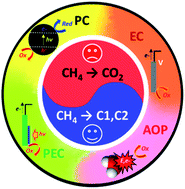Understanding (photo)electrocatalysis for the conversion of methane to valuable chemicals through partial oxidation processes
Abstract
Methane (CH4) with sp3 hybridization is known as a main constituent of natural gas, and has been utilized as a fuel and a hydrogen reservoir for power plant and transportation applications. Along with the complete oxidation of CH4 to CO2 to retard global warming, the partial oxidation toward the generation of liquid fuels is a big challenge because oxygenated products are more prone to oxidation than CH4. Therefore, the control of the charge carriers and radical species is critical to prohibit the unwanted reaction, in other words, to maximize the formation of desired products. Photo and electrocatalysis are clean and sustainable techniques for CH4 conversion, which do not require extreme experimental conditions (i.e., high temperature and pressure), and indeed, the reaction can be driven under sunlight (i.e., charge carriers generated by light absorption or photovoltaic-assisted electricity). In this review, we discuss how to design catalysts to overcome the bottlenecks in the photo and electrocatalytic partial oxidation of CH4 with focus on (i) an interfacial charge transfer process, (ii) strategies for surface engineering of catalysts, (iii) key factors affecting the reaction mechanism and rate-determining step, and (iv) a systematic investigation of the reaction conditions to lift up the catalytic performance. Finally, we propose the milestone to guide not only the preparation of catalysts that can effectively generate charge carriers and intermediates with a mild oxidation behavior but also the design of reactors for scale-up to prevent undesired reaction pathways.

- This article is part of the themed collections: 2023 Journal of Materials Chemistry A Lunar New Year collection and Journal of Materials Chemistry A Emerging Investigators


 Please wait while we load your content...
Please wait while we load your content...